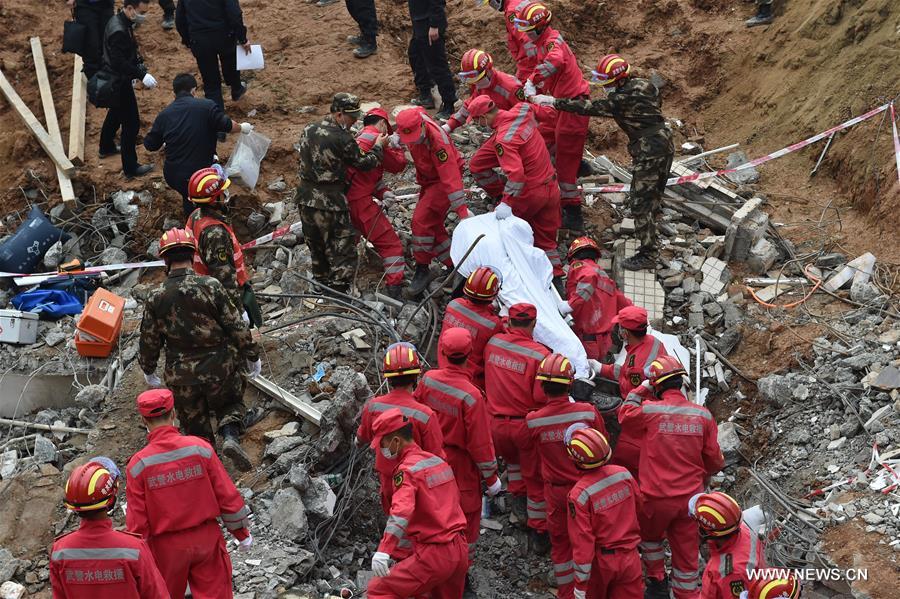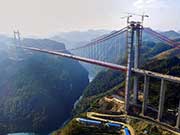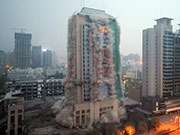


A trapped person is found dead at the site of landslide at an industrial park in Shenzhen, south China's Guangdong Province, Dec. 23, 2015. There was one survivor pulled out alive while the other found dead at the landslide site by far, but still 75 missing in the landslide. (Xinhua/Liang Xu)
SHENZHEN, Dec. 23 -- After narrowly escaping being buried alive, Li Qiying said she had never expected the huge pile of soil and waste outside her dormitory window could collapse all of a sudden.
The massive landslide happened at noon on Sunday at an industrial park in the southern Chinese metropolis of Shenzhen. By Wednesday afternoon, only one person was rescued, two were found dead and more than 70 others remained missing, with many of them being migrant workers like Li.
"I was washing vegetables in the factory kitchen as usual when my son broke into the door, grasped my hand and dragged me out of the building like crazy," said 54-year-old Li, who worked in the Hengtaiyu Industrial Park as a factory cook.
"We ran and ran until reaching a farmland. We looked back, the buildings were falling down one after another," she recalled. "We are the lucky ones, but my nephew is still buried down there. He was sleeping in at that moment."
Li has been wandering around the disaster site with other relatives of those who remained missing, anxiously awaiting miracles.
Rescuers, cranes and sniffer dogs are racing with time searching for survivors. A collapsed building protruding from the giant earth mound poses a sharp contrast to the high-rise blocks not far away.
TRAGEDIES IN A ROW
Once a fishing village, Shenzhen pioneered China's reforms and opening up policies over the past three decades to become an economic hub. It is the third metropolis in China to witness severe tragedy this year.
On New Year's eve, a fatal stampede at a crowded square in Shanghai's Bund area killed 36 revelers who were celebrating.
Eight months later, two explosions ripped through a warehouse storing hazardous chemicals at Tianjin Port, claiming 173 lives, including 104 fire fighters.
Both of the incidents were thoroughly investigated. They found lack of public security awareness and the neglect of safety oversight on the part of local officials were blamed.
In Shanghai, eleven officials were punished, with four removed from their posts. In Tianjin, a senior port executive was sacked and a nationwide safety check was launched following the incident.
While the cause of the Shenzhen landslide is being investigated, people were shocked to find the massive earth that buried 33 buildings, including 14 factory buildings, two office buildings, one canteen, three dormitories and 13 low-rise buildings, was actually from an abandoned quarry that was transformed into a trash dump.
Official statistics showed the landslide covered 380,000 square meters with residue soil of 10 meters deep. It also damaged a section of the second West-to-East natural gas pipeline, partially cutting off the natural gas supply to Hong Kong.
" Who could have thought the danger would come from the dump? " said Li Qiying.
Wang Yongquan, another resident who narrowly escaped with his five-year-old daughter, said he often saw trucks carry construction waste to the dump. "We never thought it could be dangerous," he said.
As the three severe tragedies all occurred in economically better-off areas, many Chinese are calling for an overhaul of loopholes in city management to ensure people's lives.
DISASTER PREVENTION MATTERS MORE
Rescuer Chen Lijin, an officer with the armed police force who also took part in the Tianjin blast rescue, said the rescue work is always challenging.
"Human life is the most precious, and precaution is of paramount importance. Relevant departments should take a closer look at safety to prevent such kind of things from happening again," said he.
Teng Wuxiao, a researcher of urban public safety with Fudan University in Shanghai, said, "The tragedies compel us to ask: why we did not recognize the safety hazards beforehand?"
"Compared with the ability to deal with the aftermath, we are still lacking risk assessment and disaster prevention," he said.
The dump site responsible for the Shenzhen landslide had been there for years. The risk hazard should have been foreseeable and safety measures should have been adopted," he added.
Zhong Kaibin, professor of emergency management with Chinese Academy of Governance in Beijing, agreed that Chinese cities should improve their safety pre-warning mechanisms and carry out systematic risk assessment.
Local authorities should no longer place the importance of economy over that of public safety. The new concept of achieving people-oriented urban development proposed by the central leadership must be seriously implemented, he added.
In a statement released on Tuesday following the Central Urban Work Conference, China's policymakers pledged to optimize the urban development mechanism, stressing that safety should be the top priority in city development and management.
"There is no shortcut in city management. Only by seriously implementing safety measures in every alleyway, every community and every factory of the cities can we really ensure a healthy growth," Teng Wuxiao said.
Day|Week

 Spectacular aerial photos of the Three Gorges
Spectacular aerial photos of the Three Gorges Admit it! That is a High-way built by China
Admit it! That is a High-way built by China Photos of Beijing Film Academy student hit the Internet
Photos of Beijing Film Academy student hit the Internet Spectacular aerial photos of the Three Gorges
Spectacular aerial photos of the Three Gorges New balls please! Polish sports stars strip off for risqué calendar
New balls please! Polish sports stars strip off for risqué calendar A glance at life of Ukrainian models working in Chongqing
A glance at life of Ukrainian models working in Chongqing Contestants of Mrs. Globe pose for photo in Shenzhen
Contestants of Mrs. Globe pose for photo in Shenzhen
 Bikini models attend hot pot banquet in Hefei
Bikini models attend hot pot banquet in Hefei 118-meter-high Never-used Building in NW. China Demolished
118-meter-high Never-used Building in NW. China Demolished J-10B fighters with homegrown engine in test flight
J-10B fighters with homegrown engine in test flight